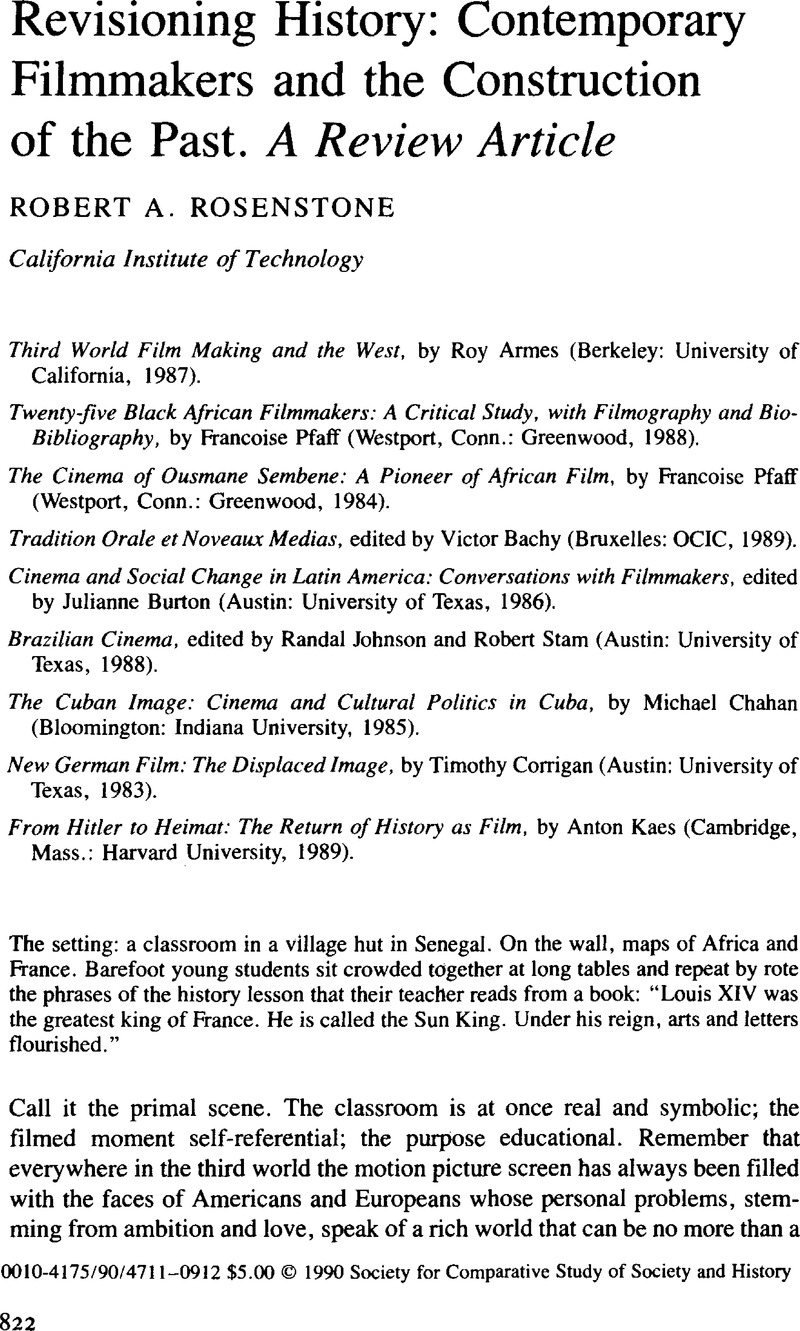Article contents
Revisioning History: Contemporary Filmmakers and the Construction of the Past
Published online by Cambridge University Press: 03 June 2009
Abstract

- Type
- CSSH Discussion
- Information
- Copyright
- Copyright © Society for the Comparative Study of Society and History 1990
References
1 Quoted in Burton, Julianne, ed., Cinema and Social Change in Latin America: Conversations with Filmmakers (Austin: University of Texas, 1986), 150.Google Scholar
2 Armes, Roy, Third World Film Making and the West (Berkeley: University of California, 1987), 99.Google Scholar
3 This essay will bypass the issue of who exactly is “author” of a motion picture. For practical purposes, I shall name directors as the individuals responsible for given works. Given the point of this essay, to investigate the many ways of doing historical films, the concept of who ís responsible for a film is not really important anyway. It should, however, be pointed out that many of the authors of the books mentioned here worry about the problem. Even those who do not believe that the director is really the “auteur” of a motion picture find themselves utilizing the concept. It is a difficult one to avoid. Perhaps the best explanation comes from Timothy Corrigan in New German Cinema: “While this investigation uses this notion as a hermeneutical device and the filmmakers often exploit it as a distribution strategy, it is certainly not … an entirely suitable classifier but rather an often grudgingly accepted image that aids communication” (p.xii).
4 Quoted in Pfaff, Francoise, Twenty-f?ve Black African Filmmakers (Westport, Conn.: Greenwood, 1988), 176.Google Scholar
5 Ibid., ix-x
6 Quoted in Francoise Pfaff, The Cinema of Ousmane Sembene (Westport, Conn.: Greenwood, 1984), 165.Google Scholar
7 Ibid., 29.
8 Ibid., 166.
9 Quoted in Burton, , Cinema and Social Change, 158.Google Scholar
10 Ibid., xi.
11 Quoted in Ibid., 107.
12 Ibid., xii.
13 Ibid.
14 Quoted in ibid., 139.
15 Chaha, Michael, The Cuban Image: Cinema and Cultural Politics in Cuba (Bloomington: Indiana University, 1985), 248.Google Scholar
16 Quoted in Johnson, Randal and Stam, Robert, Brazilian Cinema (Austin: University of Texas, 1988), 216.Google Scholar
17 Ibid., 50.
18 Ibid., 224.
19 Quoted in Kaes, Anton, Hitler to Heimat: The Return of History as Film (Cambridge: Harvard, 1989), 26.Google Scholar
20 Quoted in Corrigan, Timothy, New German Film: The Displaced Image (Austin: University of Texas, 1983), 7.Google Scholar
21 Ibid., 147.
22 Kaes, , Hitler to Heimat, xi.Google Scholar
23 Quoted in Corrigan, , New German Film, 151.Google Scholar
24 Kaes, , Hitler to Heimat, 49.Google Scholar
25 Ibid.
26 Ibid., 107.
27 Ibid., 111.
28 Quoted in Burton, , Cinema and Social Change, 174.Google Scholar
- 1
- Cited by




